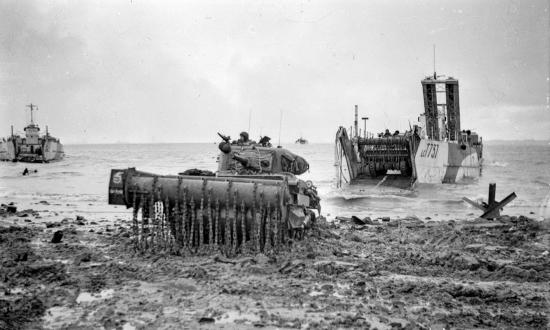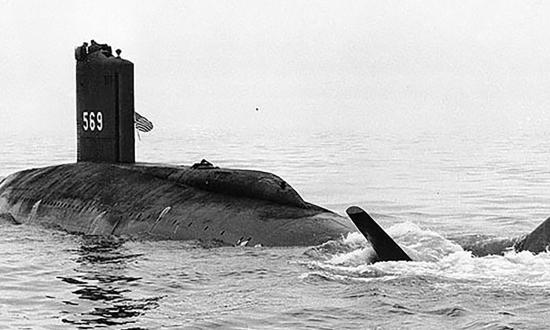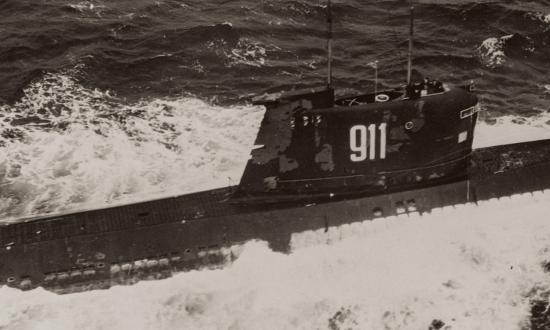One of the most challenging post–World War I operations was clearing the North Sea Mine Barrage, a group of vast Allied minefields stretching from the Orkney Islands to Norway that contained about 70,000 mines. More than 50,000 of the explosive devices were U.S.-made Mark 6 mines, designed specifically for use in the great North Sea barrier. Each contained 300 pounds of TNT and featured a complex, innovative detonation device.
Sweeping the fields sown with Mark 6 mines fell to the U.S. Navy, and a force of ships and smaller vessels would spend months of breathtakingly dangerous work to complete the task. While minesweepers come to mind as the primary ships for this work, a relatively unknown part of the clean-up story is the role played by 110-foot U.S. submarine chasers.
Of the 441 SC-1–class U.S. submarine chasers built, 303 were commissioned and assigned to duties in World War I; 133 served overseas, primarily from bases at Corfu, Greece; Plymouth, England; and Queenstown, Ireland. The era’s smallest commissioned U.S. warships, the wooden-hulled subchasers hunted U-boats and joined naval blockades to help prevent the passage of submarines. While many returned to the United States soon after the conflict, some were assigned to help clear the minefields in the North Sea.
Tools of WWI ASW
Antisubmarine warfare (ASW) during World War I was a new science; the tools and tactics for countering the submarine menace were being invented on the fly. Mounted on board submarine chasers were depth-charge launchers and racks, deck guns, and various listening devices that were top secret at the time but primitive by modern standards.
Many of the devices were purely mechanical. The C-Tube Hydrophone was essentially an inverted T of metal tubes with rubber bulbs at the lower ends and a stethoscope-style headset at the top. A listener turned the tubes and attempted to locate the direction of the sound of U-boat propellers. However, there was also great deal of experimentation with electrical and magnetic devices. For example, the Mark 6 mine featured a battery-operated detonator. Like other mine designs, the 34-inch-diameter Mark 6 had horn-type triggers built into the mine casing. But it also had a long, flexible copper antenna held up by a float. When a metal hull touched the antenna, it created an electric current that caused a coil inside the mine to rotate, dropping a ball from a cup and closing the circuit to the detonator.
A device that worked similarly to the antenna was used by antisubmarine vessels to locate U-boats. To counter a submarine tactic of “playing dead” on the ocean bottom, hiding from surface vessels hunting them, chasers were fitted with a reel of phosphor-bronze wire. One end was connected to an indicator in the pilothouse, and a weight was attached to the other end of the wire, which was reeled out and trailed the vessel as she crossed above an area where a U-boat would be suspected of hiding. If the wire struck a metal object, a slight electrical current triggered the indicator’s alarm.
It was a fine idea, but there were no reports of chasers locating a submarine with the device. Unlike the ingenious copper antenna of the Mark 6 mine, the trailing wire went largely unused after proving impractical and ineffective. A more successful invention was the K-Tube Hydrophone—not in fact a “tube,” like the mechanical listening devices on board the chasers, but a triangular frame fitted with microphones and designed to allow the listener to determine the direction of a sound source.
While the chasers and other ASW vessels were testing and using these new devices, minelayers were building the North Sea Mine Barrage by sowing rows of mainly Mark 6 mines. By tethering the mines at varying heights—45 feet, 80 feet, 160 feet, and 240 feet—the minelayers effectively created a deadly curtain.
The Minesweepers’ and Subchasers’ Task
The barrage was a formidable wartime barrier but afterward posed a dilemma. Removing the minefields required innovative thinking, and the stakes were high: Unless the mines could be swept by the end of the summer of 1919, trade routes might be closed during the coming winter, when weather would prohibit further removal. Thus started another largely improvisational effort that would involve U.S. subchasers. On 7 February 1919, the commander of U.S. Naval Forces in Europe, Rear Admiral William S. Sims, ordered 20 chasers to be readied for duty in the minesweeping force:
Prepare 17 chasers for duty at Inverness and sail them to Inverness as soon as ready. Three chasers now in Scandinavian countries will be sent to Inverness. Length of this duty will be indefinite and vessels should carry adequate supply of spare parts. All remaining chasers should be assembled in one or two convoys and sailed to Brest for passage to Gibraltar and United States.
The U.S. stars of the upcoming mine-clearing operation would be Lapwing-class minesweepers—157 feet, 10 inches long and 35 feet, 6 inches abeam. But 24 U.S. submarine chasers also would help in the effort. The minesweepers were fitted with special equipment and would test a variety of tactics:
Sweep cables and kites. The main tool of the minesweepers was a serrated sweep cable strung between two sweepers and set at a given depth with metal kites. The goal was to cut the cables securing the mines to their anchors and detonate them.
Electric protective device. To protect a sweeper from accidental detonations of mines through inadvertent contact, a wire with a metal plate carrying an electrical charge was trailed in the water to form an electromagnetic field around the ship to neutralize the effect of hitting a mine or its antenna.
Transverse and longitudinal sweeping. Tactics were tested and adapted on the fly. After early tests, transverse sweeping—running at right angles to the minefields—was abandoned in favor of longitudinal, or parallel, sweeping.
Electrical sweeps and antenna sweeps. An idea to use electricity to detonate the mines by sending an electrical current from the sweep cable to the steel tethers that secured the mines to their anchors was tested but abandoned as ineffective. Similarly, the initial tactic of cutting the tethers during first passes by sweepers resulted in too many cases of mines fouling the sweep lines. The lines were raised, and a new tactic of sweeping the antennae first proved more effective. A report of 29 September 1919 noted:
Tally has been kept by the antenna sweeping division of the number of mines which explode on contact with the sweep-wire and those that fail to explode. It was found that 25% were failures, and the cause of such failure may be sought in deterioration of the [mines’] firing battery, the accumulation of copper salts on the plates and antennae, and broken connections.
The Work of Shooting Mines
No method for sweeping the minefields resulted in detonating all the mines. Inevitably, active mines floated to the surface. This is where the submarine chasers came into play. Their job was to steam behind the sweepers so that their crewmen could shoot any mines that didn’t detonate. For this effort, the men were armed with Lewis machine guns and plenty of rifles, some of which had been already on board.
One might imagine that a steel sphere containing 300 pounds of TNT would be an easy target. But the subchaser sailors would be shooting at the bobbing mines from the decks of 110-foot-long, 15-foot-wide wooden motorboats that rolled to the rails in heavy seas. Hitting a mine with rifle fire didn’t necessarily cause it to detonate. The marksmen on board the chasers typically had to hit one repeatedly to sink it.
The decks were cleared of ASW equipment, which was no longer needed. After crewmen received target-practice training, the subchasers soon were over the minefields. In a letter home, Lieutenant (junior grade) George Dole, commanding officer of SC-354, described what it was like to follow the minesweepers:
We arrived at the field about 5:00 p.m. and the Buoy Div. started to sweep and locate the field. From 5:30 to 9:30 we shot down 86 mines. We were sure busy. It takes at least 10 shots to sink a mine, and the motion of the boat and mine does not help to make mines easy to hit. We are not supposed to go within 100 ft. of a mine, but when the sweepers cut a bunch of them you have to get up fairly close or you do not have time to get them all.
We worked with the buoy division for the following two days and shot down 250 mines (total). On one cut the sweepers cut 65 mines. Ten exploded.
Countermining—the detonation of one mine causing other mines to detonate, sometimes a whole string of them—was a danger. Essentially, the entire original area of a minefield remained dangerous after a sweep; sometimes mines detonated well afterward. In a 7 June 1919 memo, Rear Admiral Joseph Strauss, Commander, Mine Force, Atlantic Fleet, wrote, “Mines continue to explode at night after the sweepers have left the field, probably on account of leaks started by nearby explosions, which, filling the mines, short-circuit the firing device.”
Subchasers Take a Beating
Minesweepers and chasers alike engaged in the work with the crews’ understanding that a mine could destroy their vessel at any time. The detonation of a mine fouled in the USS Richard Bulkeley’s sweeping gear kite sank the minesweeping trawler, which had been on loan from the Royal Navy. Many other minesweeping vessels suffered damage from exploding mines. While no chasers were lost at sea due to them, many were damaged.
Lieutenant Dole described how his crew’s mine-shooting resulted in damage to SC-354:
We shot down one [mine] that exploded close aboard, throwing an engine off its base and opening up the seams underwater, so that we had to keep the bilge pump working all the time at full capacity to keep afloat. No one was hurt. Just my luck not to have a camera at hand when the explosion occurred. It sure did give us a bath.
An 8 June 1919 typical report noted damage suffered by SC-208:
Longitudinal sweeping buoy 47 to 30 cast 20 to 47, accounting for total 130 mines as follows: 70 exploded, 50 cut, 10 countermined. Had twelve sweep partings. Subchaser 208 reported a leak due to mine she was firing at exploding underneath. Dispatch to Kirkwall with SC 47 and Teal [(Minesweeper No. 23)] in charge. Request Teal return immediately with any spare gear you have ready. Require relief for Thomas Buckley, sub chaser 47, sub chaser 208, and sub chaser 356 tomorrow.
On 17 June, SC-164’s chart house was damaged, and SC-46 suffered a similar incident on 11 July. The next day, SC-47 approached a floating mine and crewmen opened fire. The mine detonated, and the explosion broke five windows in the pilothouse, split the structure’s after side, and broke the chart table. There were no injuries other than cuts and bruises, but thereafter it was proposed that the chasers operate with the pilothouse windows open.
On 2 and 3 August, chasers SC-38 and SC-37 suffered light damage; later, a mine explosion beneath SC-38 badly damaged the vessel. According to a Navy report of the 4 September incident:
All engine beds were broken and engines capsized, the deck was torn loose from the beams, and the hull split in various places. The vessel was towed to Kirkwall Harbor by the USS Heron [(Minesweeper No. 10)]. Repairs were found to be impossible and the vessel was towed to Inverness, Scotland, and sold.
Considering that each of a submarine chaser’s three engines weighed 6,300 pounds, the blast that threw them off their bases must have been dramatic.
Foul weather, for which the North Sea is famous, further complicated the sweeping. Yet the minesweeping force kept working while maintaining meticulous records of the sweeps with the goal of accounting for as many of the total mines laid as possible.
‘Hard and Hazardous Task’ Done
It wasn’t until September 1919 that the task was considered completed; the officers and men on board the chasers and other U.S. vessels looked forward to the homeward-bound journey. In a 31 August 1919 letter home, Lieutenant Dole wrote:
The work of minesweeping is about complete. It looks as if we would not get back on the fields again, as we have just returned and the work will probably be completed before our turn comes around again. Would not be surprised if we set sail for Devonport, Eng. on the 5th of September. Expect to go in drydock there, and get hull recaulked, and in readiness for the long trip across.
A Navy memorandum on 3 October 1919 summarized the loss of life:
Two officers and nine men were killed during the operations and, including the Richard Bulkeley which was lost, 23 ships were damaged by mines during this hazardous operation. This figure is based only on the reports received to date, and in many cases the same vessel was damaged on different occasions.
In a 26 September 1919 letter to Rear Admiral Harry S. Knapp, naval attaché in London, Rear Admiral Strauss wrote:
I have just issued to the officers and men who have done this work, a letter of appreciation for their loyalty and cheerfulness while engaged in this very hard and hazardous task. My feeling about it is entirely heartfelt and is not in any way guided by the somewhat prevalent fashion of administering praise by the wholesale. If I had not been fortunate in having such zealous subordinates the work would have lagged on well into next year.
U.S. submarine chasers had crossed the Atlantic Ocean under their own power, supported naval blockades, hunted enemy U-boats, and sailed to northern Russia to help with the evacuation of U.S. troops during the Russian Civil War. But of their work clearing the North Sea minefields, Lieutenant Dole noted, “This work is easily the most spectacular of any we have yet been in.”
Sources:
Incident reports and letters are from Navy Subject File, 1910–1927, Record Group 45, Inventory 18, National Archives and Records Administration.
The stories described by LTJG Dole are from Todd A. Woofenden’s Hunters of the Steel Sharks: The Submarine Chasers of WWI (Signal Light Books, 2006) with some additional quotes from Dole’s letters.
“‘The Northern Barrage’: Taking Up the Mines,” Navy Department, Office of Naval Records and Library Historical Section (Washington, DC: Government Printing Office, 1920), ibiblio.org/hyperwar/NHC/USN-WWI/Northern-Barrage-Taking-Up-Mines/Northern-Barrage-Taking-Up-Mines.htm.












